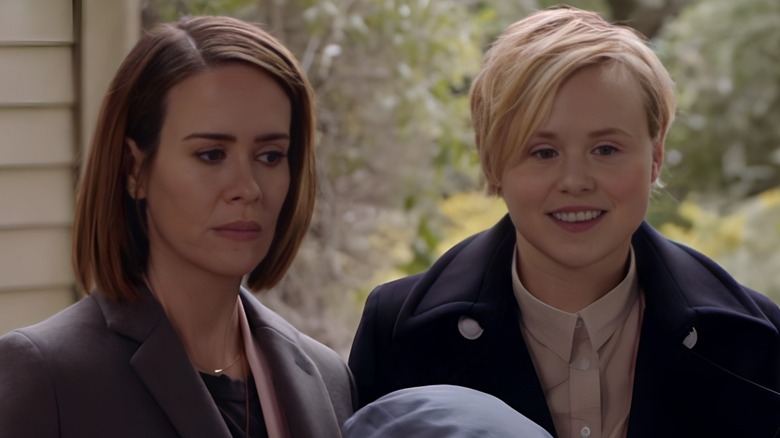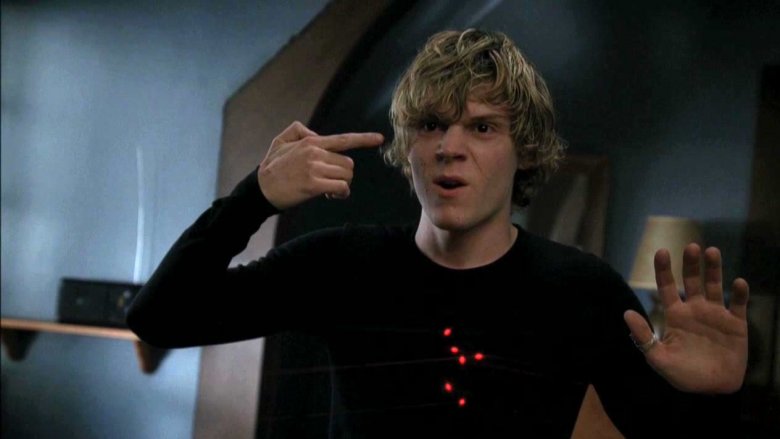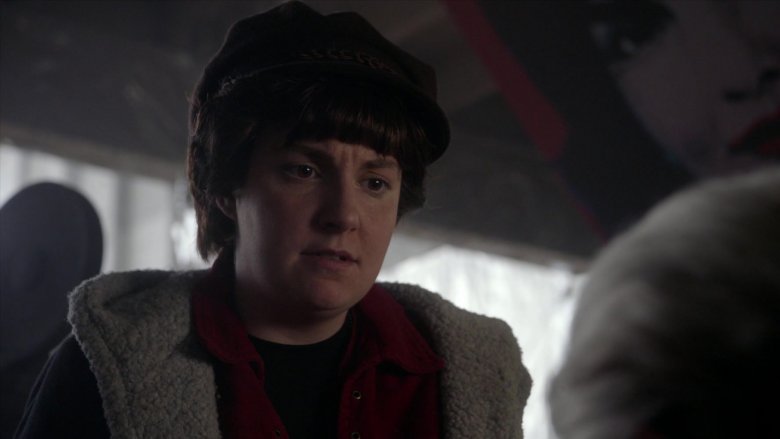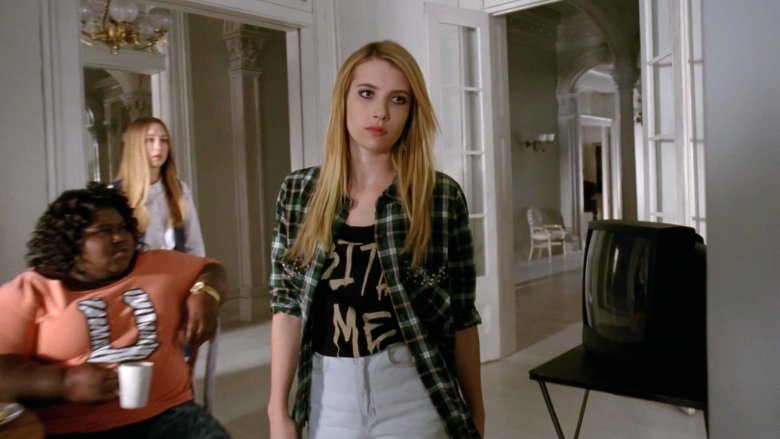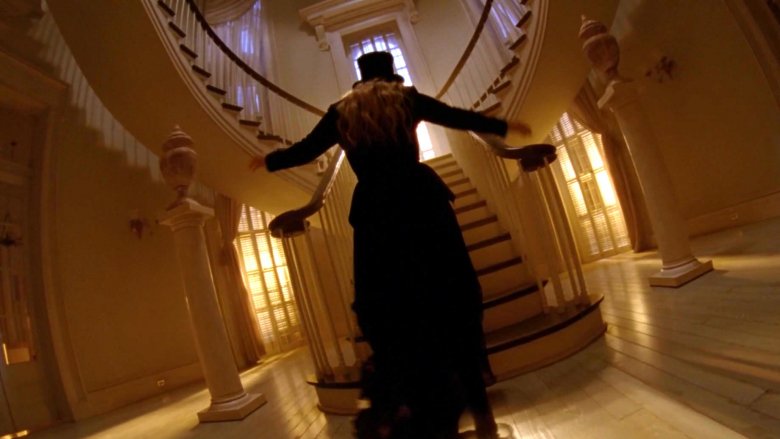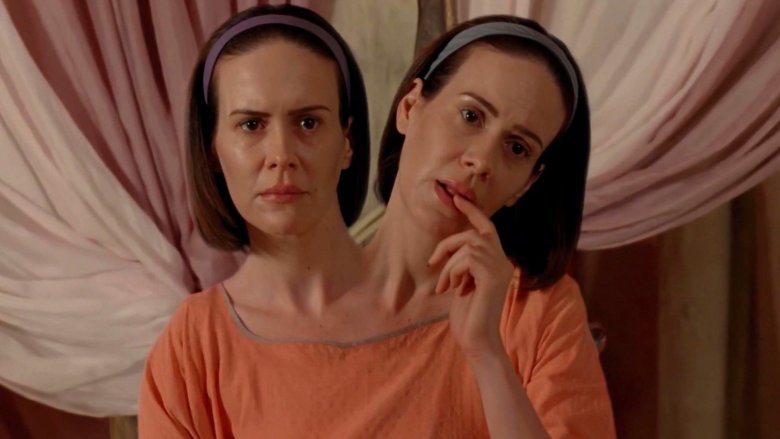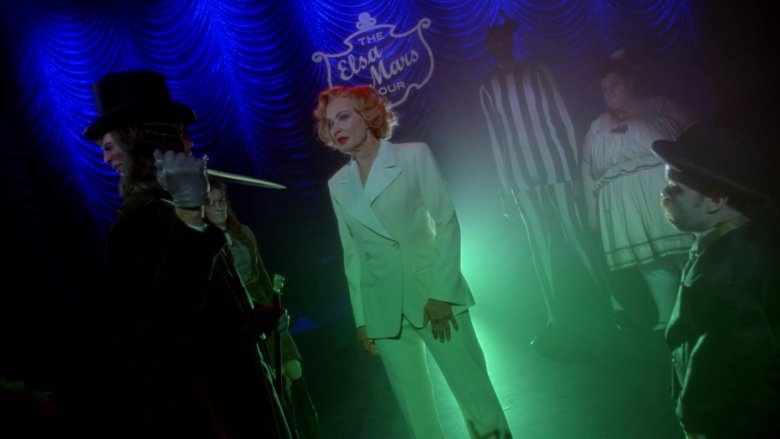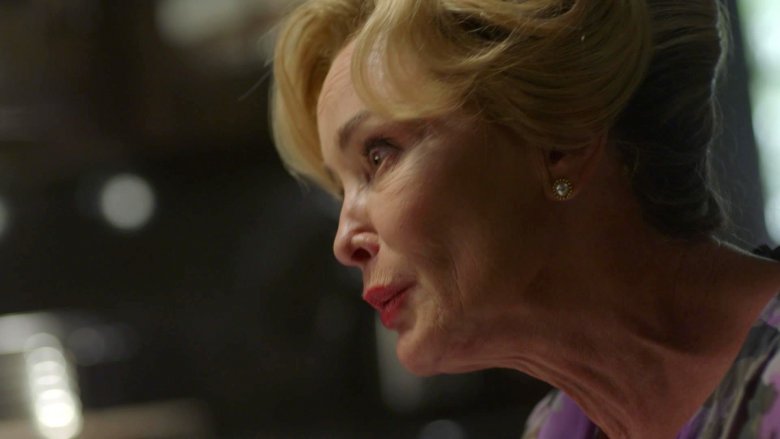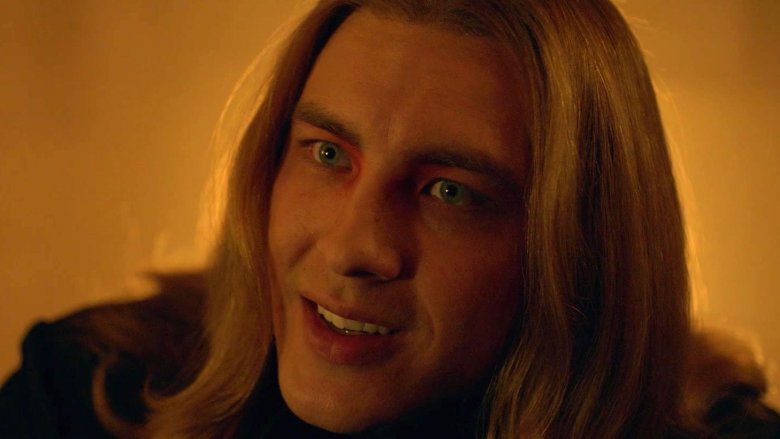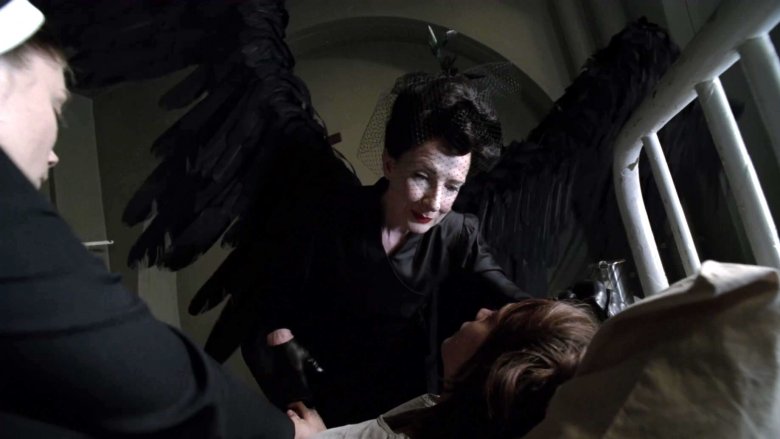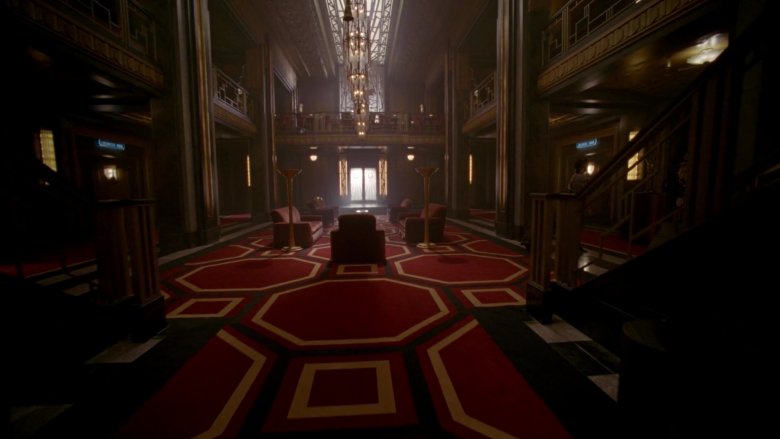The 5 Best And 5 Worst American Horror Story Episodes
Anthology series have become extremely popular in recent years — harkening back to the age of the Twilight Zone (which will be returning as well, thanks to Oscar-winning horror aficionado Jordan Peele, who will serve as the host and narrator), a growing number of showrunners are turning to the format for a fresh storytelling technique. From HBO's True Detective to the British series Black Mirror to FX's adaptation of Fargo, directors and writers have found themselves inspired by the anthology, and whether the shows keep the same cast for each installment or change it up entirely, audiences keep tuning in for each new concept.
When Ryan Murphy's American Horror Story premiered in 2011, it helped usher in a new age of anthologies, although Murphy stuck to a very specific format: he used the same core cast playing different characters for each new season, which was focused on a different horror scenario. From murder houses insane asylums to carnivals to the apocalypse, American Horror Story has covered plenty of terrifying ground, but there are bound to have been some huge hits and some big misses along the way. Here are the 10 best and worst episodes of American Horror Story.
Best: Piggy, Piggy (Murder House)
American Horror Story broke onto the scene with Murder House (though the season's name was assigned after it aired), a traditional haunted house story of a dysfunctional family who unwittingly move into a doomed new home. The Harmon family — Vivien (Connie Britton), Ben (Dylan McDermott), and their daughter, Violet (Taissa Farmiga) — are trying to weather plenty of family issues, including Ben's affair and Vivien's miscarriage, and encounter a number of odd neighbors, including the brooding Tate (Evan Peters) and the controlling Constance (Jessica Lange) as they uncover the dark history of the house.
In "Piggy, Piggy," the season's sixth episode, one specific mystery is solved — specifically, that Tate is not a neighbor at all, but a ghost who resides in the house, as Violet discovers when she looks him up online and realizes he was a school shooter who was killed by a SWAT team in 1994. Tate, however, is unaware that he is dead, and audiences are introduced to Billie Dean Howard (played by Sarah Paulson, an indispensable cast member for seasons to come), a medium who can help him with this discovery. In classic AHS tradition, the episode is jam-packed, including a revelation that Vivien is pregnant with the Antichrist and a subplot involving one of Ben's troubled psychiatry patients, but the emotional core remains with Violet and Tate, who confess their love for one another and stand by each other through each frightening realization that they encounter.
Worst: Valerie Solanas Died For Your Sins, Scumbag (Cult)
In the aftermath of the 2016 election, Murphy went with his timeliest concept yet — though it wasn't immediately obvious that Cult would focus on the recent election, Murphy announced the inspiration before it aired, setting audiences up for what was sure to be a polarizing season. With regulars Sarah Paulson and Evan Peters taking the helm as a "liberal snowflake" and a power-hungry right-winger, respectively, the season had a strong concept, but, as American Horror Story tends to do, it tried a little too hard to juggle too much, including more unnerving neighbors (played by Billy Eichner and Leslie Grossman), a roving band of killer clowns (that might be a figment of Paulson's imagination), and more.
The seventh episode of the seventh season, "Valerie Solanas Died For Your Sins, Scumbag," utilizes a relatively clumsy flashback to feminist figure Valerie Solanas (Lena Dunham), who shot Andy Warhol in 1968 at the Factory as an act of rebellion. Though this did actually happen — and Solanas was a real person — the script takes some fairly wild liberties with her story, using her creation of SCUM (The Society for Cutting Up Men) to prove that she was, somehow, the person responsible for all of the Zodiac Killer correspondence, eventually tying up the episode by using Bebe Babbott (Frances Conroy) to tie the two timelines together. Together, all these muddled messages made for an unsatisfying episode.
Best: Bitchcraft (Coven)
One of the more whimsical seasons of the entire show, the third installment of American Horror Story focuses on a coven led by Fiona Goode (Jessica Lange), the ruling Supreme who will do anything to hold onto her throne. Descendants of survivors of the Salem Witch Trials, the coven is made up of Cordelia (Sarah Paulson), Fiona's overshadowed daughter; Madison (Emma Roberts), a haughty movie star and recovering drug addict; Queenie (Gabourey Sidibe), a "human voodoo doll;" Nan (Jamie Brewer), a sensitive clairvoyant; Misty (Lily Rabe), who can revive anything from the dead; and Zoe (Taissa Farmiga), who can kill any man if they get too "close." Each of these witches attend the Academy, with Cordelia as headmistress, and throughout the season, they continue to hone their powers, wield them against outside forces, and fine-tune them in the hopes of becoming the next Supreme.
The season premiere, "Bitchcraft," gives viewers a perfect introduction to this enormous coterie of characters, which will only grow throughout the season (Denis O'Hare, Angela Bassett and Evan Peters eventually all join the cast), setting up the fight for Supreme, as well as introducing us to a terrifying villain — real-life figure Madame Lalaurie, who imprisoned and tortured slaves in her New Orleans attic in the 19th century. Throughout all of this setup, the premiere doesn't feel clumsy or expositional, but rather, like it's setting up a successful season while keeping the audience entertained.
Worst: Seven Wonders (Coven)
Though Coven was a positively received season, it ended with an enormous whimper. With the season building to one question — who will be the next Supreme, the once-in-a-generation witch who can harness all of a set of powers referred to as the "Seven Wonders" — the coven of witches are all prepared to battle it out for the title, despite Fiona's repeated attempts to take out her competition (including trying to murder Madison). As each witch makes her way through the tests, she's stumped by one element or another: Misty can't transcend her own personal hell and return to the realm of the living; Zoe has issues with transportation and is impaled on a fence; Queenie struggles with resurrection; and Madison, though mostly successful, ends up murdered. Cordelia ends up coming through as the Supreme, which, after pitting the girls against each other all season, feels utterly underwhelming.
Even an appearance by Stevie Nicks, who opens the episode with a short impromptu music video, can't save this lukewarm finale, which culminates in Fiona's personal hell — being trapped in an old farmhouse for eternity with one of the season's recurring ghosts. Watching Jessica Lange frantically scream about the house's foundations does elicit some chuckles ("knotty pine" has a whole new meaning for Coven fans), but as a whole, this ending doesn't do any service to the rollercoaster of a season that preceded it.
Best: Monsters Among Us (Freak Show)
When it comes to American Horror Story, it's often typical for season premiere tend to start off strong, even if the rest of the season doesn't follow suit. Freak Show is no exception — even though the season ranks quite low among the others, "Monsters Among Us" is a standout episode in its own right. Audiences meet Elsa Mars, played by Jessica Lange in her final full season of American Horror Story, as she rescues conjoined twins Bette and Dot (both played by Sarah Paulson) from a hospital, only to place them in her freak show, along with Ethel Darling, a bearded lady (Kathy Bates) and her claw-handed son, Jimmy (Evan Peters), amongst others. The episode also seamlessly introduces Twisty (John Carroll Lynch), a terrifying, murderous clown, as well as socialite Gloria Mott (Frances Conroy) and her deranged son Dandy (Finn Wittrock), who are perhaps a little too interested in the freak show. To cap it all off, Elsa performs a David Bowie song to close out the episode ("Life on Mars," to be specific), and reveals her own secret — she's a double amputee.
The premiere of Freak Show is an excellent example of a successful start: it expertly sets up the rest of the season, and despite the season that follows, it remains one of the standouts of the entire series.
Worst: Curtain Call (Freak Show)
Even though it had an extraordinarily strong start, Freak Show, much like its predecessor Coven, ended with a fizzle. After a seriously weird whirlwind of a season, Dandy is on a mission to kill every cast member of the freak show — he now owns the entire carnival, since Elsa has left town and sold it to him for a mere $10,000. With the business of the freak show aside, most of the finale focuses on Elsa herself, who moves to Hollywood and marries an executive (David Burtka), but allows herself to be escorted to the afterlife by the ghost of Edward Mordrake (Wes Bentley), who kills any freak that performs on Halloween. In her final performance, she sings "Heroes," harkening back to her previous Bowie performance and watched by the surviving freaks (including Bette, Dot, and Jimmy), before being gently escorted back to the freak show, where her deceased brethren are waiting with open arms.
Though it seems like a fairly warm and happy ending to such a violent season, it not only leaves plenty of narrative threads in the dust, but is simply a lackluster closing to an arc that once held so much promise. Unlike Asylum, which provides closure by giving Lana Winters one last act of revenge, Freak Show pretends it's giving viewers a satisfying ending, when ultimately, it looks more like the showrunners weren't sure where to go with such a challenging and off-the-wall season.
Best: Return to Murder House (Apocalypse)
The eighth season of American Horror Story was advertised as the ultimate crossover, connecting Apocalypse, Coven, and even Murder House. Despite the inherent difficulties of using the same actors season after season (both Sarah Paulson and Evan Peters, for example, inexplicably played three separate characters in this season alone), Apocalypse mostly did a surprisingly great job of folding previous seasons into its story. In this episode, Coven's Madison and a new (male) witch, Chablis (Billy Porter), purchase the original Murder House and return to it, trying to discover the secrets within. There, they find Ben, Vivien, Tate, Violet, and finally Constance, marking Jessica Lange's return to the series after her apparent final appearance in Freak Show, who tells Madison and Chablis that Michael Langdon, the powerful male witch who has surfaced in their midst, is the Antichrist, confirming their suspicions.
Though crossovers can often feel clumsy or forced, this episode works outstandingly well, bringing back beloved actors and characters from the show's successful first season to great effect (and ending with a touching reunion between Tate and Violet), but perhaps the best move was bringing back Jessica Lange, who left after Freak Show. Her presence was deeply felt as the seasons progressed, and letting this veteran serve as the key to Apocalypse's central mystery felt like everything in the entire series had come full circle — not to mention that some of the flashbacks were genuinely terrifying.
Worst: Sojourn (Apocalypse)
It was a bold move on the part of Apocalypse to literally present audiences with the Antichrist in the form of Michael Langdon, Vivien's demonic son from Murder House who was subsequently raised by Constance — one would think the Antichrist would be, well, frightening. The show steered directly into this skid in its eighth episode, which aired on Halloween (an airdate usually reserved for a fairly sensational installment). Allowing most of the episode to serve as a standalone flashback, Michael loses his closest parental figure, Mead (Kathy Bates, though she's later resurrected as an android), only to wander through the woods to "find himself," which results in him stumbling into a Satanic church, where the congregation cares for and begins to worship him.
Fans flocked to Twitter to declare that this was the single worst episode of American Horror Story to ever air, which seemed a bit dramatic, but again, the Halloween timing is important to consider — the show squandered a perfect opportunity. With plenty of questions left to answer and a typically superb supporting cast left in the dark for an entire episode, fans were left wanting from what should have been a sensational episode.
Best: Name Game (Asylum)
It's consistently ranked as the best season of the entire series, so it's difficult to choose the best episode of Asylum, a sophomore arc that suffered from zero slumps whatsoever. The finale, in which Lana Winters (Sarah Paulson) takes her revenge on her murderous son and triumphs by force of sheer will, was a strong contender, but the top spot has to go to "Name Game," if only for the heightened, trippy dance sequence starring Jessica Lange from which the episode takes its title. Lange's Sister Jude has become an inmate at the asylum after running it at the beginning of the season, and after being broken out of her hallucination by Lana, the two team up to escape. Elsewhere in the episode, Sister Mary Eunice (Lily Rabe), who has been possessed by the devil, kills herself after being exorcised, leading the asylum's nazi doctor, Dr. Arden (James Cromwell), to take his own life as well, climbing into the crematorium with her lifeless body.
This episode is a perfect showcase for the best of everything that American Horror Story has to offer — sheer fantasy, indelible images, and dramatic moments (including a touching turn by Frances Conroy as the Angel of Death, who arrives to collect the dead throughout the episode). When it's at the top of its game, the show looks a lot like this; a love letter to both camp and horror, while still letting each character experience real, human moments.
Worst: Checking In (Hotel)
If Asylum is frequently ranked as the best season, Hotel, which usually falls to the bottom of the pack (along with Freak Show), is its direct inverse. The season, which once again serves as a perfect example of American Horror Story squandering its promise, is based loosely on several hotel-related horror stories, including H.H. Holmes' murderous hotel that existed during the World's Fair in Chicago (the subject of Devil in the White City) and the 2013 disappearance of Elisa Lam at L.A.'s Cecil Hotel (which no longer exists). With Jessica Lange's exit at the end of the previous season, the show had yet another hurdle to overcome — who would serve as the leading lady? — and though Lady Gaga offered up an admirably campy turn as vampire the Countess, it couldn't save an uneven season that tried a little too hard and muddled its own story time and time again.
The premiere, however, remains the worst episode of the season, if only for its best known scene: a violent rape sequence during which Gabriel (New Girl's Max Greenfield) is sodomized by a monster known as the "Addiction Demon," which has a conical drill bit for an appendage. Critics and fans alike viewed this as exploitative and unnecessary, and it became clear that while American Horror Story was usually a guilty pleasure, this season might be veering away from the word "pleasure" entirely, setting up a grim vision of things to come.
